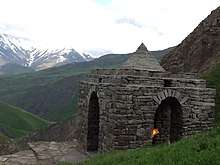Historical-ethnographic museum of Khinalug village
The historical-ethnographic museum in Khinalug village (Azerbaijani: Xınalıq tarix-etnoqrafiya muzeyi) is a museum that was established in 2001 by residents of the Khinalug village. It is located in the Quba Rayon of Azerbaijan.[1][2][3][4]
| Xınalıq tarix-etnoqrafiya muzeyi | |
 | |
| Location | Quba Rayon, Azerbaijan |
|---|---|
| Beginning date | 2001 |
History
The founder of the historical-ethnographic museum is a resident of Khinalug village, Khalil-Rahman Abdurrahman oglu Jabbarov. Rare historical exhibits, archaeological and ethnographical materials, and also carpets and kilims, various house utensils, pottery and ceramic dishes, stone books, etc., have been collected in the museum on his initiative and with help of residents of the village. The most interesting exhibit of the museum, attracting many tourists to the village, are manuscript books dated to the 15th–20th centuries and they evidence that the past of the village was closely related to science.
Characteristics
The total area of the museum, consisting of two halls, is 160 square meters. A building, where the museum is located, is reminiscent of a historical castle. Works of Rahim Alkhas, the Azerbaijani poet, native of Khinalug village are exhibited at entrance of the museum.
Khinalug village
The Khinalug village is 2,300–2,500 meters above the sea level. It is known for its language, distinctive customs, and traditions. About two thousand people live in Khinalug at this time. Nearly the whole population is indigenous. Residents of Khinalug were fire worshippers until the Islamic belief. Fire is an object of a particular respect up to now. There is a source of natural gas in the western part of Khinalug, which is called Ateshgah.
Atashgah fire temple

Atashgah (atash-kadeh), a Zoroastrian fire temple with a natural flame, located ~5 km far from the village, at an altitude of ~ 3000 m above sea level, on the spur of the mountain Shahdag, at the foot of the Gizil-gaya rock. The temple was restored on the site of the former ruins by the efforts of the World Zoroastrian Organization and the Ministry of Culture and Tourism of Azerbaijan in 2016.[5]. It was listed in the “List of state-protected historical and cultural monuments of the Republic of Azerbaijan”, ID #4647.[6]
The existence of Zoroastrian religious buildings in this part of the Caucasus are repeatedly mentioned by various authors.
Adam Olearius, a traveler of the 17th century:
“…During which time they also drive their Cattel towards the Mountain of Elbours, where they find not only a more temperate air, but also as good Meadow-ground as any in all Pesria. That Mountain is part of Mount Caucasus, and it is of such height, that though it be at a very great distance from thence, in as much as it lies on one side of Tabristan, towards Georgia, yet may it be discovered from Kale Kuhestan, and the other neighbouring Mountains of Scamachie. It was upon this Mountain of Elbours, as it is reported, that the Persians kept and antiently Worshiped their perpetual Fire: but now there is not the least track to be seen of it, neither there, nor near Jesche, though Texeira, and those who follow him, would have us believe the contrary. True indeed it is, that there are, to this day, in the Indies, certain Religious men, who have a Veneration for the Fire, and keep it in with the same care that the Persians did here to fore...”[7]
As it follows from the description and the map, Olearius called Mount Shahdag as Elburs.
Armenian clergyman Makar Barkhudariants in 1893 provides information about the ancient fire temple of Khinalig:
“... a baghin (temple) was built in a Kuba district near the village of Khinalik near a volcano called Ateshgah, where various buildings were constructed on the ancient remains by newcomers from India.”[8]
References
- "History of Xinaliq". Archived from the original on 2018-10-08.
- "Забытый в горах Кетш". vokruq sveta.
- "Не Затерянный Мир Кетша". Archived from the original on 2012-12-08.
- "Xınalıq - açıq səma altında muzey".
- Atashgah of Khinalig: the highest fire temple of the world. Hamazor Issue 1 2017 (1). World Zoroastrian Organisation
- Azərbaycan Respublikası Nazirlər Kabineti tərəfindən təsdiq edilmiş tarix və mədəniyyət abidələrinin siyahısı
- “The Voyages and Travells of the Ambassadors Sent by Frederick Duke of Holstein, to the Great Duke of Muscovy, and the King of Persia: Begun in the Year M.DC.XXXIII, and Finish'd in M.DC.XXXIX : Containing a Compleat History of Muscovy, Tartary, Persia, and Other Adjacent Countries : with Several Publick Transactions Reaching Near the Present Times: in VII Books, p. 167, “The perpetual fire of the ancient Persians”
- [Makar Barkhudariants. Aluank country and its neighbors. Tiflis, 1893(in Armenian)]